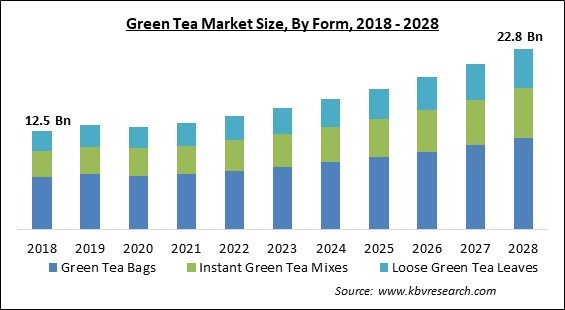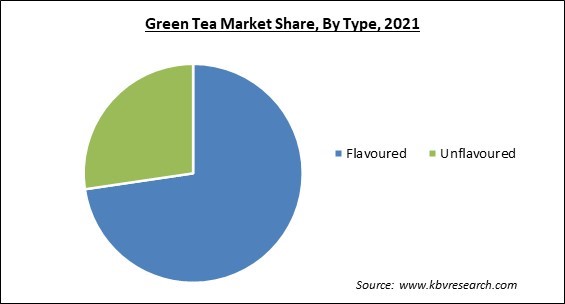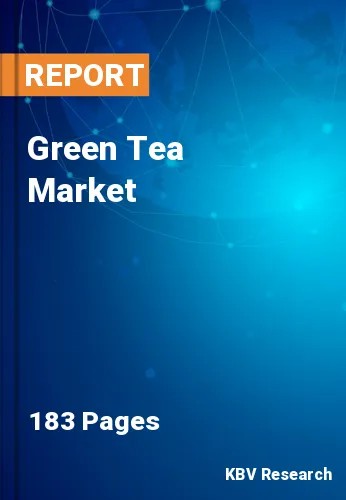The Global Green Tea Market size is expected to reach $22.8 billion by 2028, rising at a market growth of 8.1% CAGR during the forecast period.
Green tea is a very popular beverage that is produced through the Camellia sinensis plant. These plants' dried leaves and leaf buds are utilized in the production of green tea. These leaves are made by pan-frying as well as steaming them, then drying them. Among other health difficulties, green tea is known to be useful against depression and a variety of cancers, including lung cancer, colon cancer, liver cancer, and gastric cancer. Several scientific researches have also demonstrated that green tea consumption improves cognitive function and reduces cholesterol and triglyceride levels in the body.

In recent years, green tea has gained popularity among consumers all over the world due to its health benefits. Regularly drinking green tea strengthens the immune system, aids in weight maintenance, decreases physical stress, and controls skin inflammation. There are numerous types of green tea that vary significantly according to the variety of C. Sinensis utilized, the growing environment, the horticulture practices, the production processes, and the harvesting time.
The demand for green tea in various nations is ultimately driven by the preference of customers for beverages with functional advantages. This motivates people to seek out green tea products as an alternative to sugary drinks. Green tea is available in a variety of forms, including green tea bags, iced green tea, and instant green tea mixes.
It is available in a variety of flavors, including aloe Vera, vanilla, lemon, cinnamon, wild berry, or jasmine. Due to its medicinal and antioxidant characteristics, it is used in the treatment and prevention of numerous ailments, including cancer, tooth decay, diabetes, heart disease, and the maintenance of healthy cholesterol and blood levels.
As a result of the COVID-19 pandemic, the supply chain for different types of tea has faced a sudden disruption. The disruption of trade activity caused by nationwide lockdowns in many countries has hindered the expansion of the green tea sector. However, rising worries regarding immunity and general health have re-established the market for nutritional beverages throughout retail channels, During and after the pandemic, the increased interest in consuming antioxidant-rich foods and beverages in order to minimize the tendencies of infection is anticipated to raise the market for tea.
The metabolic mechanisms that turn food and beverages into usable energy are known collectively as metabolism. Green tea may aid in weight loss by increasing the efficiency of the body's metabolism. Caffeine and catechin, which is an antioxidant flavonoid, are present in green tea. Both of these substances can accelerate metabolism. Catechin can aid in the breakdown of extra body fat, and both catechin and caffeine can enhance the body's energy expenditure.
One of the major factors that are driving the consumption of green tea all over the world is the fact that it can be beneficial in reducing the risk of cancer. Apart from the health benefits of green tea, it is also beneficial in preventing cancer in the human body. Green tea consumption is frequently promoted as a natural method for lowering cancer risk. In fact, green tea is extraordinarily rich in antioxidants, which might theoretically prevent cancer by neutralizing free radicals, which are chemical by-products known to damage DNA.
Green tea is a healthful superfood that has gained significant popularity all over the world. It was initially used as a medicinal herb. It is regarded as one of the cleanest and healthiest beverages available. However, there are a few factors to consider when drinking green tea. There are numerous adverse effects, however many are uncommon. People who are allergic or sensitive to tannins or caffeine experience most of these adverse effects. The vast majority of tea consumers experience few, if any, negative side effects.

Based on Form, the Green Tea Market is segregated into Green Tea Bags, Instant Tea Mixes, and Loose Green Tea Leaves. In 2021, the green tea bags segment procured the highest revenue share of the green tea market. The lightweight and portability of green tea bags make them excellent for travel. Green tea bags make it easy to prepare tea because they are convenient and require little equipment.
On the basis of Type, the Green Tea Market is bifurcated into Flavored and Unflavored. In 2021, the unflavored segment recorded a significant revenue share of the green tea market. The rapid surge in the growth of the segment is majorly attributed to the demand for raw green tea among consumers. Raw green tea is considered to be healthier in contrast to flavored green tea as they are no additive sugar and fats in this type of green tea.
By Distribution Channel, the Green Tea Market is segregated into Supermarket/Hypermarket, Convenience Stores/Specialty Stores, and Online. In 2021, the supermarket/hypermarket segment witnessed the biggest revenue share of the green tea market. The growth of the segment is surging at a very rapid pace due to a large number of retail stores in the world. Supermarkets and hypermarkets offer the pleasure of physically inspecting and purchasing items.
| Report Attribute | Details |
|---|---|
| Market size value in 2021 | USD 13.4 Billion |
| Market size forecast in 2028 | USD 22.8 Billion |
| Base Year | 2021 |
| Historical Period | 2018 to 2020 |
| Forecast Period | 2022 to 2028 |
| Revenue Growth Rate | CAGR of 8.1% from 2022 to 2028 |
| Number of Pages | 183 |
| Number of Tables | 339 |
| Report coverage | Market Trends, Revenue Estimation and Forecast, Segmentation Analysis, Regional and Country Breakdown, Companies Strategic Developments, Company Profiling |
| Segments covered | Form, Type, Distribution Channel, Region |
| Country scope | US, Canada, Mexico, Germany, UK, France, Russia, Spain, Italy, China, Japan, India, South Korea, Singapore, Malaysia, Brazil, Argentina, UAE, Saudi Arabia, South Africa, Nigeria |
| Growth Drivers |
|
| Restraints |
|
Region-Wise, the Green Tea Market is analyzed across North America, Europe, Asia-Pacific, and LAMEA. In 2021, Asia-Pacific accounted for the highest revenue share of the green tea market. The growth of the regional market can be attributed to the presence of major green tea-producing nations such as China, India, and Sri Lanka. Because of the region's natural characteristics, such as temperature, humidity, and soil texture, are suitable for tea cultivation, many countries, especially China and India, have focused on establishing tea plants in wide areas.
Free Valuable Insights: Global Green Tea Market to reach USD 22.8 Billion by 2028
The market research report covers the analysis of key stake holders of the market. Key companies profiled in the report include Unilever PLC (Tazo Tea), Associated British Foods PLC (Wittington Investments Limited), Tata Consumer Products Limited (Tata Group), East West Tea Company LLC (Yogi Tea), Typhoo Tea Limited (Zetland Capital), Bigelow Tea, Numi Organic Tea and Northern Tea Merchants Ltd.
By Form
By Type
By Distribution Channel
By Geography
The global Green Tea Market size is expected to reach $22.8 billion by 2028.
Helps in Improving Metabolism and Reducing Body Weight are driving the market in coming years, however, Side Effects Due to The Consumption of Green Tea restraints the growth of the market.
Unilever PLC (Tazo Tea), Associated British Foods PLC (Wittington Investments Limited), Tata Consumer Products Limited (Tata Group), East West Tea Company LLC (Yogi Tea), Typhoo Tea Limited (Zetland Capital), Bigelow Tea, Numi Organic Tea and Northern Tea Merchants Ltd.
The Flavoured market is generating high revenue in the Global Green Tea Market by Type in 2021; thereby, achieving a market value of $15.6 billion by 2028.
The Asia Pacific market dominated the Global Green Tea Market by Region in 2021; thereby, achieving a market value of $8.5 billion by 2028.
Our team of dedicated experts can provide you with attractive expansion opportunities for your business.

